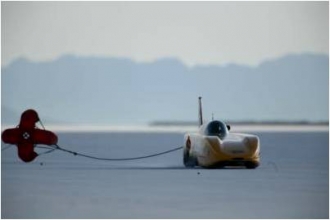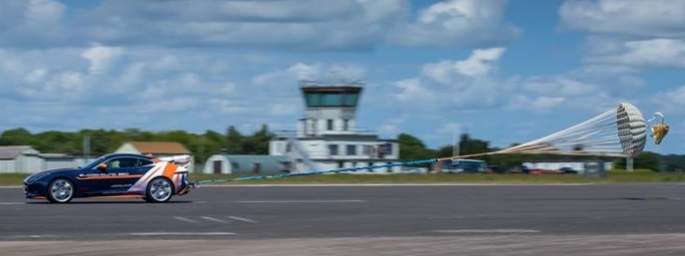BLOODHOUND SSC will be using the same parachutes as Thrust SSC as, not surprisingly, we need about the same amount of drag at the same speed.
The chute system is designed to be simple and reliable. A button on the steering wheel will pull a pin from the chute pack, allowing a large steel spring to force a small drogue chute out into the 650mph airflow. The drogue will then pull the 2 metre diameter brake chute out, together with the line (or ‘strop’).
The chute generates 9 tonnes of drag, while the strop is rated to over 21 tonnes to give us a good safety margin against unexpected ‘snatch’ loads.
Dealing with drag
A 2 metre diameter ‘ring slot’ chute will give us 90kN (9 tonnes) of drag at Mach 0.9 (670mph).
 Marlow Ropes – stopping the world’s fastest diesel car
Marlow Ropes – stopping the world’s fastest diesel car
To keep the chutes away from the turbulence immediately behind the Car, we need a 20 metre line, or ‘strop’, to attach the chute to the Car. With a 9 tonne working load, plus opening shocks of up to 50% above that, plus a 50% safety factor, that left us looking for a strop which would take an amazing 20 tonnes or so!
Step forward Marlow Ropes, which makes some of the best rope products in the world. Marlow Ropes supplied the strops for both Thrust SSC and the JCB Dieselmax, so we’ve used their kit before and we know that we can trust it.
For BLOODHOUND, we will be using a 32mm diameter braided strop. The strop will be 17 metres long to start with, but at its full working load of 9 tonnes the strop will stretch by 3 metres, reaching a total length of 20 metres.
Fitting the chute into the Car
Survival Equipment Services is our chute specialist. It packaged a sample strop and chute into a deployment bag, so that we could check the fit in the limited space at the back of the Car, which is around 1 metre by 250mm.
Testing the chute
The chute was tested by Andy Green at over 180mph in June 2015. The test took place at the former RAF base in Bentwaters, Suffolk, using a Jaguar F-TYPE R Coupé with a modified rear window and structural supports through which BLOODHOUND's unique teardrop shaped parachute cans were mounted directly to the car's chassis.
Green released the parachute using a cockpit-mounted button, subjecting the F-TYPE to an instantaneous drag force equivalent to 1 tonne that dramatically slowed the car before Green brought it to a controlled stop.
Read more about the test and watch how it went in this video.


